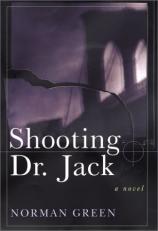Shooting Dr. Jack
Review
Shooting Dr. Jack
Every city has at least one area like it. It's not a destination area, no retail, bars, restaurants, recreational spots, it's just on the way between where you are and where you're going. There are lots of buildings, but no signs. Nothing ever changes. The larger metropolitan areas are loaded with them. If you drive by or through them at all, you drive quickly. You don't know what's going on there, and you probably don't even want to know.
Much of Norman Green's brilliant debut novel, SHOOTING DR. JACK, takes place in such an area in New York City, on Troutman Street, which, in Green's opening words "...runs from nowhere to nowhere." Just so. It is on streets like Troutman where businesses that skirt the law flourish quietly, like the nest of spiders in the storage area of your basement where you keep the pictures from your first wedding. Stoney and his associate, Tommy "Bagadonuts," run such a business, a firm in the business of importing and exporting, one which files its forms and pays its taxes and to all appearances operates within the letter of the law, except for an occasional and extremely profitable deviation.
Stoney and Tommy sense that the quiet performance of their daily operation is about to be interrupted by a series of events. The first of these occurs when Tuco, their young apprentice worker who is simple on the surface but a sea of roiling complications beneath, discovers the bodies of two neighborhood kids in an alley adjacent to their business property. The second is when their accountant is found murdered in a hotel room, with the business records scattered around him. Then, of course, there is the pain in the ass EPA auditor who is investigating the little matter of their importation of freon. And why is that burgundy Continental following them wherever they go? Matters quickly escalate when Tommy is shot. While he is in a coma, unable to identify his assailant, Stoney realizes that he is quickly running out of road.
There are, naturally, a number of secondary elements that figure into SHOOTING DR. JACK. Stoney's problems with alcohol threaten to capsize the already leaky boat that his life and his marriage have become. Tuco, who is stumbling into adulthood with an undiagnosed learning disability and an underutilized mechanical aptitude, finds himself attracted to a beautiful, crack-addicted prostitute who has just set up business on Troutman, and who, it turns out, is in debt to Miguel, Tuco's cousin. Miguel is Dr. Jack, a dreaded gang leader who controls the drug trade in the area. There are bad and unresolved feelings between Tuco and Miguel, but the web of circumstances involving Stoney and Tommy provide Tuco with a way to resolve not only their problems, but his own, and to maybe, just maybe, win the affection of the tarnished jewel he finds himself giving his heart to.
Green, in his own words, has never been one to let his studies interfere with his education. His education has apparently consisted of peering around corners where no one looks in areas where no one with honest business visits. His prose is at once straightforward, vivid and haunting, qualities that his characters possess as well. These are not people you know, though at least some of them may live down the street from you. You see their backs, but not their faces. They blend in with the bricks and mortar of the city as they quietly complete their commerce. Yet their activities affect us all in some way.
Green is reportedly working on his second novel. This is good news; he is an author to be watched as he reports on the world around us, the world that is there for observation but rarely, if ever, seen. His next dispatch will be eagerly awaited.
Reviewed by Joe Hartlaub on August 21, 2001




